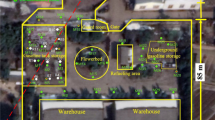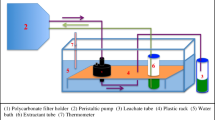Abstract
Background, aim, and scope
The membrane interphase probe (MIP™) from Geoprobe Systems® has frequently been applied in different countries for the characterization of soil contaminated with volatile organic carbons (VOCs). Experience shows that misinterpretation of the collected data is common. This is mainly due to the lack of understanding and knowledge related to the detectors used, their detection limits, and the sensitivity of the MIP system. It has been noticed that the sensitivity of the system given by the producer and by different users are rather optimistic, e.g., the values given are lower (= better) than those actually experienced in the field. A need for a better understanding of the MIP system sensitivity, combined with a more scientifically based interpretation of the collected data, exists.
Materials and method
Both laboratory tests (using solutions) as well as field measurements were carried out using different detector configurations to allow a better interpretation of the detector signals/system sensitivity and to collect qualitative information. These configurations were: (1) detectors stand alone; (2) the use of a 2-ml sample loop, and (3) a purge and trap system. The configurations (2) and (3) are used in combination with a capillary column to carry out on-site qualitative and semiquantitative analyses.
Results and discussion
With respect to the configuration of “detectors stand alone,” detection limits for toluene (in aqueous solutions) range between 4 ppm (flame ionization detector—FID) and 10 ppm [photo ionization detector (PID)]. For chlorinated aliphatic hydrocarbons (CAHs), observed limits are 10 ppm (FID), 4–50 ppm (PID), and 3–10 ppm [dry electrolytic conductivity detector (DELCD)]. When using the 2-ml sample loop, relatively high concentrations have to be initially present in the soil. Observed detection limits for mono-aromatic hydrocarbons are 5–100 ppm; for CAHs, 1–50 ppm; for alkanes, 250–400 ppm; and for MTBE, 25 ppm. The application of purge and trap results in a better resolution and the detection of lower concentrations. Consequently, a better identification of the pollution with depth is possible. In this case, the detection limits are a function of the concentrations and the flushing time. In relation to the qualitative analyses, it was found that the configuration of the MIP-system with the built-in capillary column and the 2-ml sample loop or the purge and trap preconcentrator, respectively, are useful to carry out on-site analyses, thus allowing a better identification of the pollution in a vertical profile.
Conclusions
The measurements carried out using the MIP with detectors stand-alone or in combination with a loop or trap, or connected to a column, confirm that analysis is indeed very useful to characterize VOC source zones when knowing and understanding its performance. This relates mainly to the detection limits of the MIP system. For a selection of parameters, such limits have been obtained. These values seem to be more realistic than those found in the few references where numbers are given. For the qualitative measurements, it can be concluded that a better resolution is obtained, and pollutants present in lower concentrations will be detected when using the purge and trap. It is advised to determine the optimal flushing time and the detection limit of the expected pollutants in advance.
Recommendations and perspectives
This study indicates that there is still a need for further measurements and discussion between users. Finally, additional data should result in a better interpretation of the collected field data.








Similar content being viewed by others
References
ASTM (2007) Standard practice for direct push technology for volatile contaminant logging with the membrane interphase probe (MIP). ASTM standard D7352-07
Bracke R (2001) The application of direct-push technology with respect to geomonitoring and construction issues. Ecos Umwelttechnische und -wissenschaftliche Publikationen, ECOS Umwelt GmbH., Germany, (in German: Der Einsatz von DP-Verfahren für Geomonitorings und baugrundtechnische Fragestellungen)
Christy TM (1996) A permeable membrane sensor for the detection of volatile compounds in soil. Paper presented at the National Ground Water Association’s Outdoor Action Conference, Las Vegas, Nevada, www.geoprobe-di.com
Christy TM, Gillespie G (1996) Proceedings of the Direct Push Days Workshop, Salina
Ehle N, Neuhaus M (1998) Application of direct push technology and membrane interphase probe (in German: Standortuntersuchung mit Drucksondentechnik und Membrane Interphase Probe). TerraTech 5:36–39
EPA (2005a) Sensor technologies used during site remediation activities—selected experiences. EPA 542-R-05-007. www.clu-in.org
EPA (2005b) Groundwater sampling and monitoring with direct push technologies. EPA 540/R-04/005. www.epa.gov
Geoprobe website (2007) Direct Image. www.geoprobe-di.com
Griffin TW, Watson K (2002) A comparison of field techniques for confirming dense non aqueous phase liquids. Ground Water Monit R 22(2):48–59
Lookman R, Rogge M (2000) Delineation of large soil pollution with volatile compounds using probing techniques. 300–301 In: Proceedings of the 7th FZK/TNO Conference on Conta-minated Soil, Leipzig
McAndrews B, Heinze K, Diguiseppi W (2003) Defining TCE plume source areas using the membrane interface probe (MIP). Soil Sediment Contam 12:799–813
Neuhaus M (2007) In-situ investigation of contaminated soil and groundwater with MIP- and ROSTtm—CPT. Italian Journal of Engineering and Environment, Special Issue 1. 59–63. Casa Editrice Universita La Sapienza
Rogge M, Christy TM, De Weirdt F (2001) Site contamination fast delineation and screening using the membrane interface probe. In: Breh W et al (ed) Field screening Europe. Kluwer Academic Publishers, Dordrecht, pp 91–98
SRI (2007) SRI Instruments. Peak simple download. www.srigc.com/peaksimple.htm
Touchant K, Lookman R, Bronders J, Van Keer I, Smolders R, Van Houtven D, Wilczek D (2004) Militair domein Brustem: Bijkomend onderzoek (Kerosine). VITO/2004/IMS/R/147 (VITO report in Dutch)
Van Keer I, Habtie A, Bronders J, Wilczek D, Smolders R (2003a) Validatie en toepassing van de ‘Membrane Interphase Probe (MIP)’. Deel 2: Testsite 1: evaluatie van sonderingen uitgevoerd met de Membrane Interphase Probe (MIP) op een voormalig Texacoterrein verontreinigd met BTEX, te Gent. VITO/2003/IMS/R/011 (VITO report in Dutch)
Van Keer I, Habtie A, Bronders J, Wilczek D, Smolders R (2003b) Validatie en toepassing van de ‘Membrane Interphase Probe (MIP)’. Deel 2: Testsite 3: evaluatie van sonderingen uitgevoerd met de Membrane Interphase Probe (MIP) ter hoogte van een voormalige leerlooierij, verontreinigd met VOCl’s te Zulte. VITO/2003/IMS/R/078; (VITO report in Dutch)
Van Keer I, Bronders J, Touchant K, Verhack J, Wilczek D (2008) Detection and measurement techniques to identify the presence of NAPLs in the field. In: Annable MD et al (ed) Methods and techniques for cleaning-up contaminated sites. Springer, Dordrecht, pp 59–69 NATO Science for peace and security series—C: environmental security
Author information
Authors and Affiliations
Corresponding author
Rights and permissions
About this article
Cite this article
Bronders, J., Van Keer, I., Touchant, K. et al. Application of the membrane interphase probe (MIP): an evaluation. J Soils Sediments 9, 74–82 (2009). https://doi.org/10.1007/s11368-008-0054-9
Received:
Accepted:
Published:
Issue Date:
DOI: https://doi.org/10.1007/s11368-008-0054-9




